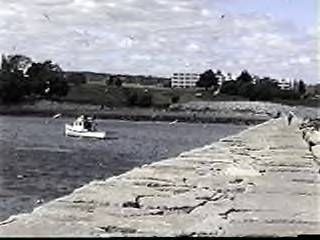
The latest communication from Army Corps of Engineers is promising:
"An RI/FS was recommended at this site due to past discovery of MEC and the MC risk associated with the COPECS"
Huh? Translated into plainer English below, but first the news: the Seal Island Site Inspection Report has been finalized "with concurrence of all stakeholders and regulators who participated with us in the process."
Okay. So what did they decide? In plainer English:
"A Remedial Investigation & Feasibility Study was recommended at this site due to past discovery of munitions and explosives of concern and the munitions constituents risk associated with chemicals of potential ecological concern" (see acronyms list, coming soon)

This is bad and good news:
Bad News: An initial quick& dirty onceover of the bombing range has revealed enough UXO to warrant developing a remediation plan. So yes, this outer Penobscot Bay gunnery range of an island is indeed contaminated.
The MK 15: most common UXO at Seal Island
Good news: The agencies and stakeholders have concurred that a plan should now be drawn up; a detailed plan for seeking out and removing or neutralizing UXO or MEC therefrom this former bombing range, which is identified on nautical charts as federal Danger Area 334.10.
The scuttle at a recent brownbagger in Army Corps of Engineers in Baltimore is that Army and DoD were talking last year about extending the scope of the area of concern to the waters the ranges out to the 125 contour (safe diving depth) eligible for cleanup; instead of the area within 100 yards of shore, (the present accepted limit.) This will be followed up on...
Now the heat is on the conservation/environmental community to act on behalf of Marine Maine down there, i.e. ensure the dangerous polluting munitions on the seafloor off Seal Island, steadily leaking into state waters and also washing ashore on nearby islands as the Gulf of Maine's currents tumble the underwater cache of UXO about is looked at, and appropriate remediation taken.
What's needed: Regional NGOs must step up to the plate.
Penobscot Bay is well-freighted with conservation and environmental non government organizations of all stripes. Commercial fisherfolk groups, coastal and island land trusts, regional environmental outfits. A shifting mosaic of grassroots groups in Maine coastal towns and cities rising and falling as they take on their particular NIMBY Nightmares.
It is historically been dififcult to impossible to draw Natural Resources Council of Maine down below the low tide line; those vast natural areas that make up Maine's state territorial sea must do without Brownie Carson's bands of merry men and women that fight the green fight so well on Maine's land and in Maine's freshwater rivers and lakes. Lukewarm interest so far. from Toxics Action Center.
So far. Time will tell. Get updated Seal Island info








